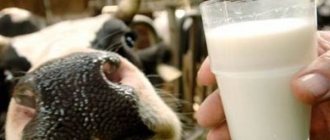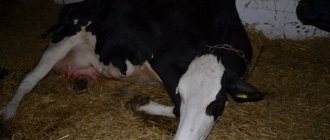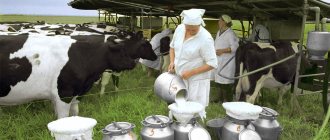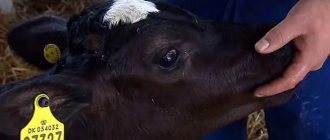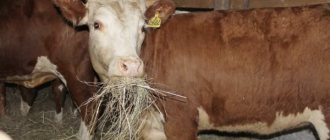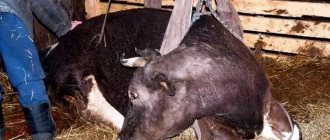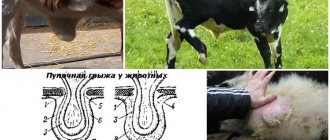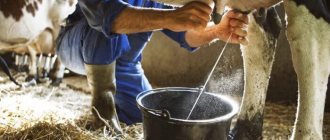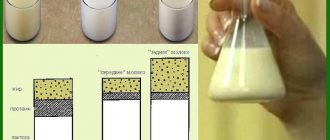Calving problems
For new farmers, the most common questions that arise are about fertilization and reproduction. If the main goal is breeding, then the animal is prepared for this from birth, and is provided with special maintenance and care. On forums and agricultural websites you can often find questions about what to do: the cow has calved, but there is no milk. The reasons can be very different - from abnormal nipple structure to inflammation of the udder (mastitis).
Usually, if all rules and regulations are followed, such problems do not arise. Conscientious owners must provide the animal with comfortable conditions before and after birth:
- How do you know when a cow will calve? This can be seen from several signs: she tries to retire, to get away from the herd. Therefore, it is best if the cow is given a separate stall, cleaned and covered with fresh bedding.
- The place where the cow will calve must be dry and free of foreign objects.
- If she is in a large room with automatic manure removal devices, care must be taken that the animal does not walk along the aisle, otherwise the calf may get caught in such a scraper.
- Provide a balanced diet and plenty of fluids, in addition to this, owners often add multivitamins and microelements to the regular diet.
Every farmer must understand that childbirth is extremely stressful for an animal, so a cow requires increased attention and care.
After calving, the cow’s udder is hard and there is no milk - what is it?
Often after calving, a cow’s udder becomes hard and swollen, but there is no milk. What should a farmer do? Inflammation of the udder or mastitis during the lactation period is a real disaster. The amount of milk during mastitis is sharply reduced or is completely absent.
It develops as a result of pathogenic bacteria entering the tissue through the nipple canal. Hypothermia or overheating of an animal can also lead to mastitis. Violation of sanitary standards and non-compliance with animal care rules increases the likelihood of udder inflammation several times.
Experienced farmers recommend paying attention to the technology of milking a cow. When starting it, you should follow the following mandatory procedures, namely:
- Wash the udder with warm water.
- Use special disinfectants before and after milking, for example “Kompomol - DC Eco”.
- Perform a light massage.
Experienced farmers inspect the udder of cows daily for redness, hardness, cracks, and abrasions. The dairy cow is kept in a clean room. When using the milking machine, always ensure that it is clean.
Video about what to do if a cow loses milk:
Conditions for successful calving
For a young female, labor can be long and painful, and in some cases the assistance of a veterinarian is necessary. In an adult, the whole process is much easier, but everything depends both on the animal itself and on the structure of the pelvis and the weight of the fetus.
In any case, the owner must be prepared in advance for childbirth and possible complications. There are several ways to find out when a cow will calve:
- the udder swells greatly and milk even begins to flow;
- she becomes restless, cannot stand in one place, moves her legs;
- the external genitalia become very red and fluid may ooze from them;
- the stomach sags;
- moans protractedly and plaintively;
- lies most of the time.
You can make your task easier and keep a special calendar immediately after insemination. Despite the fact that most cows cope with childbirth on their own, a person needs to monitor this process and, if complications arise, call a veterinarian for help.
Further actions depend on how the cow calved. What to do and how to help an animal can be understood by its behavior. If the cow calmly licks the calf and does not show signs of anxiety, then the resolution was successful, you need to give her water and leave them alone. But there are times when you cannot do without the help of a doctor.
Solutions
Despite the fact that the cow does not want to let anyone near her, she still needs to be milked at least twice a day. Otherwise, there is a high risk of developing mastitis. Therefore, the problem of kicking needs to be solved as early as possible.
Mastitis in cows
First of all, in such a situation, you need to examine the animal’s udder for injuries, damage, and signs of disease. If such undesirable aspects are nevertheless identified, it is necessary to immediately take measures to eliminate them. Moreover, milking during such a period should be carried out extremely carefully so as not to aggravate the situation and not cause pain to the cow.
If the reason is not pain, then the following tips will help during milking:
- It is necessary to accurately determine the milking schedule for livestock and follow it unquestioningly. This will not only help quickly accustom the cow to the procedure, but will also significantly increase milk yield.
- When collecting milk, you can initially pour concentrated food and vegetables into the animal’s trough, which she likes most. This will distract the cow, causing her to become calmer.
- Vaseline or other special lubricants should be used during milking. In the natural environment, a calf, feeding on milk, lubricates the udder with its saliva, which prevents it from drying out. If you milk dry, the nipples will quickly crack and cause pain in the animal.
- You can also place a wide piece of cloth, generously moistened with water, on the back of the cattle. It will calm the cow, distract it and become a real salvation in the summer heat.
If none of the above methods gives the desired effect, the heifer will initially have to be tied to the walls of the stall each time during milking. Moreover, this procedure can be implemented in different ways. If the heifer allows her owner to approach her and stands calmly, you can limit yourself to simply tying up her hind limbs. In this case, the knot on such a tie is made free so that the animal can be quickly released.
If it is not possible to approach the cow from behind, tie the front leg to the stand. In this case, a loose loop is thrown over the leg, the limb is pulled up and fixed on a strong support. The harness is placed on the leg on which milking is carried out.
READ ALSO: Apple tree Uslada
Manual milking
If a cow is raised on a farm from calf age, then already during this period of its development it is necessary to gradually accustom the animal to milking. To do this, regular touching of the udder and massage are enough. Cattle raised in this way will give milk quite calmly.
The problem of cows kicking during milking is a fairly common problem, but it is not something to be taken lightly. Often the reasons for this phenomenon are trivial and easily resolved. But in some cases they can be a sign of serious health problems and require surgical intervention.
In this article we will teach you what to do if cows are fighting while milking. It often happens that the animal becomes very nervous during milking and does not allow anyone to approach it. Or he starts kicking if he managed to start the milking procedure. This can lead to loss of milk from an overturned bucket and injury to the milkmaid. Below we will talk about how to milk a cow, including the obstinate one, and how to do it correctly. And also about how to accustom a cow to this procedure so that it does not fight.
Complications
During severe calving, the fetus may get stuck in the mother's perineum; if it is not removed in the first hours, it will die, and possibly the adult too. Removal requires at least two people and special chains and forceps; using them without a veterinarian is highly not recommended; incorrect and inept movements will only cause damage.
Special reference books and magazines can help beginners. Experienced livestock breeders give various advice here, including what to do after the cow calving. According to most, it is necessary to watch her for the first few hours.
There is a possibility of so-called paresis occurring immediately after childbirth; its manifestation is similar to the symptoms of paralysis. The animal's ears and sacrum become cold, it cannot stand up and moans protractedly. Calcium is used for treatment; it is injected into a vein or subcutaneously. The cause of the disease may be obesity, an unbalanced diet or an improper diet. Such unpleasant situations most often occur in adults.
Reasons for lack of milk
Many livestock breeders are faced with an unpleasant problem, which in short is this: what to do - the cow has calved, but there is no milk. The situation is really serious and can indicate various diseases. First of all, you need to find out the reason:
- Incorrect feeding. Nutrition should be balanced and complete. After experiencing stress, the animal needs fresh food and additional vitamins.
- Mastitis is an inflammatory process that causes a problem similar to when a cow has calved and there is not enough milk.
- The milk ejection reflex is impaired. This can occur from extraneous irritants, fear, violation of feeding periods, non-compliance with milking rules, and also due to stress after childbirth. If, when favorable conditions are created, milk is still not released, then this is a reason to contact a veterinarian.
- Ketosis is a metabolic disorder that causes harmful acids to accumulate in the body. After a diagnosis has been established, acidic foods are removed from the animal’s diet and potatoes, carrots, turnips and fresh, good hay are added.
When a person is in a difficult situation, he does not know what to do. The cow has calved, but there is no milk, and it is difficult to determine the symptoms on your own. In this case, you should seek help from a specialist.
Causes
Almost all cattle owners face this disease. Most often, mastitis in a cow occurs against the background of postpartum complications; the problem is especially acute in large livestock farms, where it is not possible to carefully follow all the rules of maintenance and care.
The most common causes of mastitis include the following:
- Incorrect diet, same type or stale food.
- Pathogenic microflora caused by improper milking technique.
- Injury to the nipples or udder.
- If hygiene standards are not observed, there is a possibility of infection in the nipple canal.
- Disease of the reproductive system.
But most often, mastitis is the result of several factors at once. Against the background of a general weakening of the immune system, any of the above reasons contributes to the development of the disease. Moreover, the disease proceeds in a closed form for a very long time and manifests itself only during lactation.
The cow lost milk: reasons
A condition in which a cow loses milk is called agalactia by veterinarians. In this case, milk is completely absent. With hypogalactia, a significant decrease in milk yield is observed, but this does not please the animal owner. What to do if such a disaster happens to a cow on your farm?
A healthy dairy cow produces about 20 liters of milk per day!
We suggest that you familiarize yourself with the main reasons why a cow may experience a decrease in milk production or completely stop producing milk:
- Seasonal low milk production is a natural state of the animal, which is observed in mature cows, as well as during the dry period. In this case, hypogalactia is not a pathology and it is unlikely that it will be possible to eliminate the problem.
- Feeding hypogalactia develops due to the fault of the farmer when the basic rules of feeding the animal are not followed. The food of a dairy animal must be high in calories, varied and of high quality. If a cow receives enough vitamin supplements and does not suffer from malnutrition, then she produces a lot of milk. A poor and monotonous diet is a common cause of hypogalactia. With diseases of the digestive tract, nutrients may not be absorbed, which will also adversely affect milk yield.
- A cow may lose milk due to stress. This happens, for example, when there is a change of owner, a long haul, a poor night's rest, or fright.
- Keeping a cow in unsatisfactory conditions can lead to agalactia. For example, prolonged exposure to the scorching sun and lack of sufficient water is guaranteed to lead to a decrease in milk production. Poor conditions in the barn can cause hypogalactia in the cow. Dampness, drafts, cold, lack of fresh air - all these are possible reasons why a cow lost milk.
- Serious animal illness is a common reason why milk goes missing. For example, mastitis in a cow, infection or poisoning - all this leads to the development of intoxication and poisoning of the animal’s body. The cow is severely exhausted by the purulent process, so it is worth carefully examining it for inflammation on the skin.
- Insufficient grazing time is a common cause during bad weather season. It is extremely important for the cow to move enough, otherwise the milk is guaranteed to disappear.
If the blood has suffered stress, then after a while the nervous system will return to normal. In other cases, it is necessary to eliminate the cause that caused agalactia in the cow and treat the animal. A consultation with a veterinarian will help you accurately determine why the cow has lost milk and what to do in this case.
Signs of mastitis
Then the problem arises. What to do if the cow has calved but there is no milk? It is this symptom that is the first when an inflammatory process occurs. In addition, you can independently determine the diagnosis based on some external signs:
- local temperature increase;
- the skin on the udder swells, and the supra-udperal nodes increase in size;
- shows fatigue, loses appetite;
- change in the taste of milk and decrease in milk yield;
- the nipple may thicken;
- the consistency of the milk changes, it disintegrates and contains flakes;
- When pressing on the udder, painful sensations appear.
If a complex form of inflammation occurs, ulcers, abscesses may appear, and the temperature may rise significantly.
Treatment
The final diagnosis can only be made by a qualified specialist, after conducting an examination and taking samples for analysis. Depending on the form and stage of the disease, mastitis in a cow is treated in different ways, but most often it includes a whole range of measures.
Timely therapy will contribute to the animal’s rapid recovery and rapid return to its normal productivity cycle. Farmers are often afraid of using antibiotics, since such milk is prohibited from being sold during the treatment period.
Therefore, in the first stages of the disease, it is recommended to use local therapy. The udder massage is carried out as follows: using light pressure, run your hand from bottom to top over the affected area several times; in addition, you can use ichthyol ointment and camphor oil.
Drug treatment of mastitis is carried out by injecting antibiotics under the skin of the animal or by injecting a medicinal suspension into the mammary glands. If the owner has experience in performing such manipulations, injections can be done independently.
How to treat
When a cow is starting, it will be more effective to use antibiotics. There should be no amateur activity in this method; everything is carried out under the supervision of a veterinarian.
Severe mastitis is treated with novocaine injections (0.25%). Only a doctor can determine how often injections can be given. You can rub in the necessary ointments with your own hands, for example, ichthyol, camphor.
The following drugs are also used to treat severe mastitis:
- Penersin A.
- Mastisan.
- Masticide.
They have long established themselves in this area.
To introduce the drug into the udder, you should use a special catheter. The course of treatment can last 3-4 days. After 5 days of intensive treatment, milk is allowed to be consumed.
When purulent mastitis is diagnosed, milk must be given every two hours. The udder should be doused with cold water. Ravinol, streptocide, ichthyol, and potassium permanganate are injected into the udder several times a day (2-3).
Whatever the type of mastitis, the animal should be kept separately from other residents of the farm. You also need to change your diet, give up greens and succulent food for a while. Food of dry origin should predominate. The amount of water is significantly reduced.
Also, during this period, you should stop milking by machine and switch to manual milking. This procedure is performed 3 times a day.
Prevention of mastitis
Any form of the disease requires the owner to comply with special conditions, otherwise all treatment will be useless:
- The cow must be protected from contact with other animals.
- Provide her with proper care and a nutritious, balanced diet.
- Milk by hand and at least three times a day.
Experienced livestock breeders recommend using some folk recipes in combination with drug treatment. So, the udder should be washed with warm salted water or nettle infusion, or a mixture of red and white clay should be applied to the udder and nipples. Veterinarians themselves advise using aloe juice to reduce the inflammatory process; it is injected into milking using a syringe.
If proper animal care measures are taken, treatment will be much more effective, and the likelihood of recurrence of the disease will be much lower.
Preventive measures include the following:
- Provide the animal with a balanced and complete diet.
- When milking, you should be careful not to “pinch” the nipples or put too much pressure on them.
- The room where the animal is kept must be constantly cleaned and ventilated.
In addition, today there are special tests for the early detection of mastitis or other infections. Regular examinations will prevent disease and maintain good milk yield.
Why does milk disappear?
In veterinary medicine, the phenomenon when a cow’s milk disappears or decreases is called hypogalactia (low milk production) and agalactia (milklessness). Both phenomena are a serious violation of the formation and release of the product as a result of improper maintenance, care and operation of the animal. However, you should not confuse these phenomena caused by natural changes, for example, old age, a dry period. In the latter case, temporary hypogalactia and agalactia are observed.
Types of agalactia and their causes
- Nutritional or feed – lack of milk as a result of violation of the norms and rules of feeding the cow. This includes starvation, lack of vitamins and minerals, little protein, poor quality feed, water imbalance, indigestion, monotony and poverty of the diet.
- Artificial agalactia - occurs in healthy animals due to stress or nervous disorder. Most often, a cow’s milk may disappear due to a violation of conditioned reflexes, a change of owner, a change in milking conditions (switching from manual to machine milking), or under-milking. Nervous excitement can be caused by a change of environment, disruption of the schedule and routine of the day, a long drive, moving in a car, etc.
- Climatic agalactia - in this case, milk disappears due to a violation of the correct “climatic” conditions for keeping the cow. For example, dampness, dirt, poor ventilation, little fresh air, stuffiness, little light. Regardless of the time of year, the animal must go out into the yard, take a walk, and have the right diet. Also, milk may disappear if the cow is kept grazing for a long time in the heat, under the scorching sun.
- Exploitative agalactia is a phenomenon caused by the excessive use of an animal. For example, poor preparation for lactation, intensive milking, early calving, extended lactation (more than 300 days), a decrease and increase in the number of milkings can lead to the loss of milk. Very often, intensive milk production in the first months is accompanied by an increase in milk yield, and then a sharp decrease or complete cessation of lactation.
- Physiological - in this case, agalactia occurs due to some disease. For example, it can be caused by mastitis, inflammation of the udder, inflammation of the uterus, and food poisoning. However, in all these cases other accompanying symptoms are also observed. With mastitis or inflammation, milk does not suddenly disappear. First, its quantity decreases due to pain during milking, deterioration of milk production and other reasons. And only without timely treatment can complete agalactia occur.
- Stagnation is another very common cause of agalactia. It occurs in cows that spend a lot of time lying down, walking a little, moving and walking. In principle, it could be classified as a climate group, but still it is more related to animal care. In winter, due to various weather conditions, many livestock farmers forget to walk their cows. They, in turn, rest a lot and lie down. The result is complete agalactia. Also, lactation is disrupted in cows after calving if they lay a lot during the dry period.
Calf care
After giving birth to a cow, you must immediately think about the fate of the offspring. The fact is that the baby is born with virtually no immunity, and in the very first hours it needs to receive a special substance from the mother - colostrum, the survival of the young directly depends on this. Subsequently, an equally important question arises about how to feed the calf.
In the first two months, he should receive 3 to 4 liters of milk per day daily, sometimes a substitute is used. Feeding can occur using nipples (on large automated farms) or directly from a bucket; with any method, it is necessary to ensure that the container is clean and free of foreign objects and products.
The prosperity of livestock farming depends primarily on caring for the young animals; more attention should be paid to the issue of how to keep the animal and how to feed it. The calf must be provided not only with milk, but also with clean water, concentrated formulas and hay. Young individuals are usually kept in groups, they must be vaccinated, disinfected and marked with ear tags.
How to increase a cow's milk yield?
It is quite logical that every breeder who builds a business on milk production wants to get the highest possible milk yield from his cattle. But if a cow gives little milk, you need to either slaughter the animal or help it. It is the second option that is chosen most often due to expediency. But how to increase the amount of milk from a cow?
Provide cows with good and high-quality nutrition
- Provide the cows with good and high-quality nutrition. It should be varied, rich in vitamins and, most importantly, of high quality and fresh. Moldy grain, spoiled mash, damp and fungus-covered hay, rotten waste from root crops and vegetables should not be given to cows!
- Take your animals for walks as often as possible. Within reasonable limits, of course. Quite often, breeders who keep animals in stalls do not understand why the cow gives little milk, but the fact is that they do not go out to graze. Cows should not walk in the rain or snow, during strong winds or slush. This is not safe and cruel to the animal, which values warmth and comfort no less than humans. But on warm days a walk is necessary!
- Monitor the health status of each cow. Any problems, illnesses, symptoms should be considered and not go unnoticed, since not only the amount of milk of the cow, but also her life may depend on the speed of the breeder’s response.
- Massaging the udder makes it more elastic and pliable for milking, so the amount of milk with regular massages and lubricating the udder with special ointments only increases. Just do the massage carefully, with smooth movements, so as not to damage the nipples or delicate skin.
Helpful information
An experienced livestock breeder is familiar with the situation when a cow calved prematurely and there is no milk; questions arise for beginners, especially in small farms where the owner is responsible for all maintenance and care processes. However, if you follow a proven algorithm of actions, serious problems can be avoided.
Summarizing all the information related to calving of cows, the following conclusions can be drawn:
- It is necessary to provide animals with acceptable living conditions: clean bedding, complex food and modern preventive measures to prevent diseases.
- Closely monitor the cow during pregnancy and after calving, detect complications in time and eliminate them yourself or by calling a veterinarian.
- The success of a livestock enterprise depends on the birth of healthy offspring, so it is necessary to provide the calves with comfortable living conditions from the very beginning.
Raising cattle requires endurance, patience and certain knowledge and skills. You cannot raise cows on enthusiasm alone; you need a clear understanding of your responsibilities.


